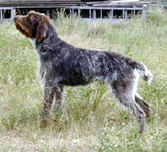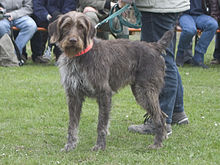Deutsch Drahthaar
History:
The Deutsch-Drahthaar was created in Germany in the late 19th century. A few visionary and dog revolutionist set out to develop a versatile hunting dog that would satisfy ALL aspects of German hunting in field, forest, and water. This group of breeders succeeded in creating a versatile hunting dog that took its traits from the best dogs of the existing coarse hair breeds, cross bred with the shorthair blood. In short the mane parent breed contributors are and included the Stichelhaar, Pudelpointer, Griffon, and the Deutsch-Kurzhaar. The success of this breed and that is the number one hunting dog in Eroupe. This succes is completly due to the test system. where all dogs must pass the strict requirements to help us measure and improve the breed only the best of the best are used to further the breed.
The Deutsch-Drahthaar was created in Germany in the late 19th century. A few visionary and dog revolutionist set out to develop a versatile hunting dog that would satisfy ALL aspects of German hunting in field, forest, and water. This group of breeders succeeded in creating a versatile hunting dog that took its traits from the best dogs of the existing coarse hair breeds, cross bred with the shorthair blood. In short the mane parent breed contributors are and included the Stichelhaar, Pudelpointer, Griffon, and the Deutsch-Kurzhaar. The success of this breed and that is the number one hunting dog in Eroupe. This succes is completly due to the test system. where all dogs must pass the strict requirements to help us measure and improve the breed only the best of the best are used to further the breed.
Deutsch Drahthaar
VDD BREED CLUB:
A group of breeders founded the Verein Deutsch-Drahthaar (VDD) in May 1902. The driving force behind the Deutsch-Drahthaar, Freiherr Sigismund of Zedlitz and Neukirch, demanded that the primary breeding goal of the hunting dog be versatile performance ability. His thoughts became the principle of the VDD breeding program: “through performance to standard”. This principle is still upheld today, with registered breeders following a tradition of required performance and physical evaluation for all of the dogs used in the breeding program.
Many breeders of the German Wirehaired Pointer (GWP) errantly refer to their breed as Drahthaar. In addition to significant differences in breed standard, the Wirehair has been bred without regulation or restriction since the late 1950’s, but especially without the performance testing that proves the ability of the Drahthaar. After years of unrestricted breeding and no versatile performance standards the German Wirehaired Pointer has evolved into a distinctly separate breed. WE ONLY BREED THOSE THAT MEASURE UP TO THE STRICT STANDARD WHICH TAKES ABOUT 2 YEARS TO ACHEIVE. THIS ENSURES WE ONLY BREED THE ELITE. WHICH GARANTEES YOU ABOUT A 98% CHANCE TO GET IF NOT THE BEST DOG YOU HAVE EVER OWNED ACOMPLISHED HUNTING AND EQUIPPED HUNTING DOG
Characteristcs:
The Deutsch-Drahthaar is a mid-sized, substantial dog. The height at shoulder varies from around 61 to 68 cm for males, and 57 to 64 cm for females. The coat is generally wiry, and tightly fit with a thick under coat. This coat was developed to provide protection for moisture, cold and heat, as well as thorns, brush and insects . The eyebrows beard give the DD his characteristic appearance. The breed has a variety of colorations. They are: brown and white ( brishimel) which is most common. also black and white ticked ( Swarschshimel) you may also find and solid brown
(Braun )with or without a white chest patch.
Today’s DD is the most popular hunting dog in Europe, and is rapidly gaining popularity elsewhere, and that is not without reason. The Deutsch-Drahthaar is a passionate, hard-working dog. They are noted for their endurance and willingness to obey, as well as the ability to concentrate on the work at hand. After persistently and effectively searching the field with its keen and sensitive nose, the DD shows the hunter the game by pointing your query. Shot birds are hunted down and retrieved on land or on water to the handler In particular, DD’s exhibit the characteristic of a retriever of lost game the Drahthaar is most excellent after the shot. They do this by their capacity to track and pursue (and even dispatch) wounded game with tenacity in some of the most difficult conditions on land and on water. This saves the game from unnecessary suffering. Their endurance, swimming ability and heavy coat also make them well suited to waterfowl hunting in the most adverse conditions.
While the Deutsch-Drahthaar is a superb hunting companion, they are also well suited as a family dog. DD’s are normally gentle and friendly with children and other dogs, and are known to become protective of their “family” and home. Their intelligence and calm manner help them in adjusting to various living conditions. VDD Breeding Regulations specify that DD’s who show unwarranted aggressiveness toward people or other dogs are to be removed from the breeding program, so these traits do not get passed on. From my experience I believe the drahthaar works best with structure and a proper introduction to all situations. As with all genuine hunting/working dogs, the DD needs legitimate specialty training and consistent guidance. Only when given sufficient training and activity does he seem content.





